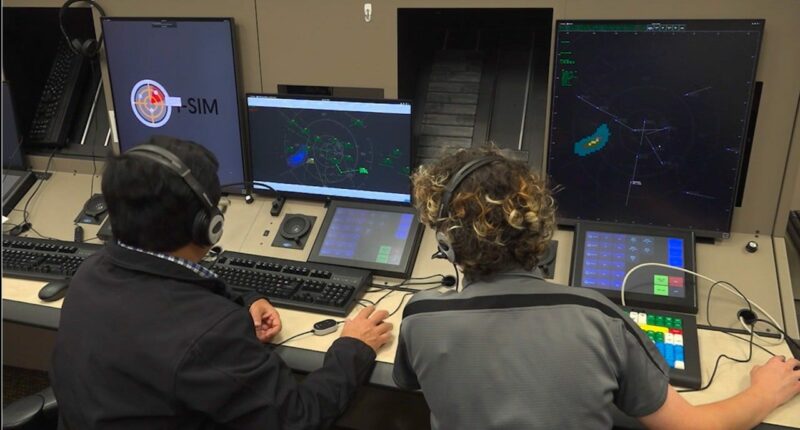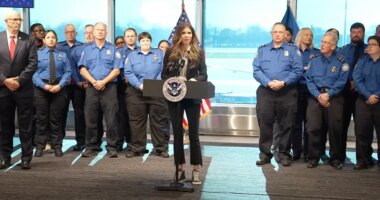Share this @internewscast.com
In Eastman, Georgia, a national shortage of air traffic controllers has sparked renewed interest in a burgeoning educational pathway that the Federal Aviation Administration (FAA) endorses at select colleges.
The recent federal government shutdown brought the issue of staffing shortages into sharp focus, as air travel disruptions, including delays and reroutes, became more frequent across the nation.
The FAA aims to recruit at least 8,900 new controllers by the year 2028. Data from the FAA workforce, analyzed by USAFacts, reveals that approximately 3,000 controller positions were vacant nationwide by the end of 2024, although the level of understaffing varies by location.
This shortfall is increasing interest in a relatively new FAA-approved collegiate program that aims to expedite controller training at a select group of institutions, such as Middle Georgia State University.

As students progress through this program, their training intensifies, requiring them to manage multiple aircraft simultaneously using radar systems, according to Fox News.
The Enhanced Air Traffic Collegiate Training Initiative (AT-CTI) program provides students with training equivalent to that of the FAA Academy. Upon hiring and fulfilling FAA criteria, such as passing the Air Traffic Skills Assessment (ATSA) and obtaining medical and security clearances, graduates can proceed directly to an air traffic control facility, bypassing the full academy program in Oklahoma City, which often entails long waitlists and several months of courses.
Graduates still undergo facility-specific training and must be certified on-the-job before becoming full controllers.
Only about nine schools nationwide have been approved to offer the new Enhanced AT-CTI program as of 2025, according to Kemarie Jeffers, the department chair of aviation science and management at Middle Georgia State.
Inside Middle Georgia State’s tower simulator, air traffic control student Brooke Graffagnino says the job’s intensity is what drew her in. “It kind of gets your chest beating, because with how much traffic there is, sometimes it is intense,” she said.

Students also train inside the on-campus control tower, gaining experience with real airport operations. (Fox News)
She says students quickly find out whether they’re suited for the job. “You can kind of tell who does not [love it]. There have been quite a few, and they are no longer here. It takes a lot to get through it,” she said.
Graffagnino says the importance of the work became clearer as she learned how controllers keep busy airspace organized. “Once you get in the airspace that is super crowded or approaching the larger airports like Atlanta, you need someone to help coordinate and keep everything separate and safe,” she said.
Middle Georgia State was approved as an Enhanced AT-CTI school in mid-2024. Jeffers says the impact was immediate.
“Before our program had maybe about 17 to 20 students. Right now we have 54. So we have already, in that short amount of time, almost tripled in size the amount of students that we have,” he said.

An instructor helps a student navigate radar-based air traffic training during an advanced simulation. (Fox News)
To earn the enhanced designation, Jeffers said the school had to update its curriculum, overhaul parts of its simulator setup, and install new audio and video systems.
“We’ve upgraded a lot of our equipment… we had to install audio and video equipment upstairs in our tower sim,” he said.
Those upgrades allow the FAA to remotely review or spot-check training sessions and ensure they meet federal standards.
The program’s biggest distinction is what happens after graduation. “Enhanced CTI eliminates your requirement of going to the academy. You will graduate here and you can go straight to work,” Jeffers said. “So it saves you time and effort — again, it gets you to work sooner and making money quicker.”
The FAA requires enhanced programs to employ instructors with controller experience and maintain simulator equipment comparable to FAA standards.

A comparison of the traditional FAA route to becoming an air traffic controller and the newer Enhanced AT-CTI pathway. (Fox News)
As students advance, the simulations become more complex, requiring trainees to manage more aircraft at once.
“As we get more comfortable and confident, we are able to allow more aircraft into the airspace at a time,” Graffagnino said.
Before finishing the program, every student must pass a final simulation that mirrors the FAA Academy’s evaluation process.
“Our instructors will then run a scenario and they will be graded… the exact same way in which they will be graded at the academy,” Jeffers said.
According to the FAA’s FY 2025 Air Traffic Controller Workforce Plan, the agency anticipates about 2,000 hires in FY 2025, 2,200 in FY 2026, and incremental increases through 2028, though retirements are expected to offset much of that growth.

















